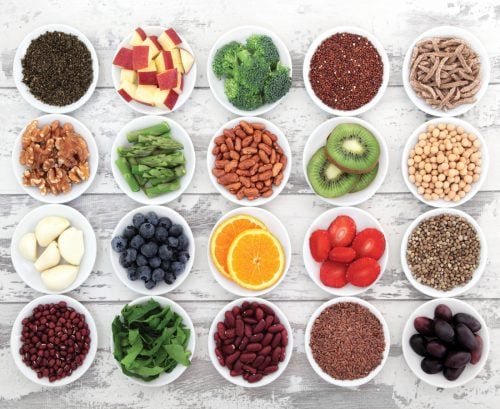
Fibre doesn’t necessarily conjure up the most exciting thoughts but dietitian Katrina Pace shows why it is the unsung hero of the food world.
Fibre, as boring and brown as it sounds, is a star when it comes to helping us maximise our health. It is a type of carbohydrate that can’t be digested by the body, which is why it’s sometimes called ‘roughage’. Ensuring we get enough roughage in our diet can reduce our risk of being overweight, or getting type 2 diabetes, heart disease and certain types of cancer. And, rather than cutting down on what we eat for weight loss, we can eat more high-fibre foods to really help us get healthy and shed unwanted kilos.
Carbohydrate foods include vegetables, fruit, legumes, seeds and whole grains. Not all carbohydrates are created equal, so while some people are cutting the amount of carbohydrates they eat in an effort to be healthier, they also run the risk of cutting the type of carbs that are superheroes for our health.
Results from a recent analysis of research investigating the health effects of the quality of carbohydrate we eat, reinforced how paying attention to our fibre intake means we can experience great health in the short and long term.
What is fibre?
‘Dietary fibre’ is the term we use to describe the part of plant foods that isn’t digested or absorbed in the small intestine. Rather, it is completely or partly fermented in the large intestine. Fibre is only naturally found in plant foods, but nowadays we’re finding other foods, such as dairy, with added fibre extracts.
Resistant starch
Resistant starch is a type of dietary fibre that is not digested but, rather, fermented by bacteria in the colon. Found in legumes, seeds, grains, green bananas and certain cooked and cooled starchy foods (such as potatoes and rice) the amount of resistant starch depends on how a food is prepared. Resistant starch is one of the favourite foods of our gut bacteria.
Soluble fibre
Soluble fibre mixes with water in the gut and forms a gel-like substance that slows down digestion. This helps us to feel fuller for longer, while giving our body time to absorb nutrients and delay the absorption of sugar into our blood stream. Psyllium husk, legumes, oats and ground flax seeds are all high in soluble fibre.
Insoluble fibre
Insoluble fibre doesn’t mix with water but acts as a bulking agent in our bowel.
Insoluble fibre draws water into the bowel, softening the stool and making it easier to pass. Therefore, insoluble fibre is often recommended to help prevent constipation and improve regularity. Examples of foods high in insoluble fibre are bran products, whole wheat, legumes and nuts.
Functional fibre
Functional fibre is dietary fibre taken from the food it’s naturally found in and added to food products or processed foods. It can also be produced synthetically. Examples include, Metamucil (psyllium), and Benefiber (wheat dextrin).
Chicory root extract, also known as inulin, is added to many products, such as snackbars, to increase fibre and sweetness. While functional fibre may be used to increase your fibre intake, having many whole food sources of fibre means you benefit not only from the fibre itself, but the other nutrients found in these valuable foods.
Why is fibre good for us?
The functions of fibre, mainly in our large intestine, are what make it so good for us. One thing fibre does is give bulk to the waste products that find their way down to our bowel. Our bowel is one long muscular tube and, like any muscle in our body, it needs exercise. The bulk from fibre gives our bowel muscles a good work out, helping to prevent conditions such as haemorrhoids and diverticular disease.
Fibre reduces the speed of digestion, giving our body time to harvest the nutrients we need to keep healthy. Slowing digestion also helps stabilise blood sugar levels and helps us feel fuller for longer.
Fibre is also a prebiotic (food for our gut bacteria) which helps us grow a healthier balance of flora. There’s lots of research linking gut bacteria to mental health, heart health, diabetes risk (types 1 and 2), inflammatory bowel disease and weight.
As dietary fibre is fermented by the bacteria living in our bowel, they produce short-chain fatty acids that can help reduce inflammation and the risk of certain types of cancer. Fibre can also increase the feeling of fullness and improve insulin sensitivity.
Certain types of fibre seem to help maintain the health of the cells that line our digestive system. They do this through protecting and maintaining the mucous layer, as well as ensuring a healthy balance of gut bacteria that protect our digestive tract lining.
How much fibre do we need?
The Ministry of Health’s suggested dietary targets are 28g daily for women and 38g daily for men, however the 2008 National Nutrition Survey indicated the average fibre intake for adults was only around 20g a day.
Furthermore, a recent analysis of research showed, for adults, 25g-29g of fibre daily is beneficial for our cardiac and metabolic health. The data also suggest that more is better, so 30g is the magic number to enhance both our short and long-term health. Other research has found having 30 or more different fibre sources every week is associated with greater microbial diversity in our gut.
How does fibre help me…
Lose weight
Diets high in fibre or whole grains can help people who are overweight to lose weight in several ways. First, there’s a link between inflammation, body weight and gut bacteria, and a diet high in fibre improves the gut bacteria profile, so it’s similar to that of someone who is a healthy weight. Studies have shown that (high-fibre) prebiotic foods can help with weight loss. Second, the time it takes to chew fibre foods, and their physical bulk, can help us feel full. Finally, that fullness lasts longer because a gel-like substance some fibre forms slows the release of sugar into the blood after eating. This means we’re likely to eat fewer unneeded kilojoules, helping us to shed any unwanted kilos.
Reduce my risk of type 2 diabetes
A large European study of approximately 12,000 people found that fibre from vegetables and wholegrains can reduce the risk of developing type 2 diabetes. Higher fibre foods moderate the rise in blood sugar after eating, meaning the body doesn’t have to produce as much insulin. Gut bacteria also play a role in inflammation, a condition that may predispose people to type 2 diabetes and can play a part in weight regulation. Obesity is an important risk factor for the development of type 2 diabetes.
Protect my heart
A high-fibre diet may help protect your heart by reducing cholesterol levels in the blood, and improving blood sugar levels, blood pressure and weight which are all risk factors for heart disease. Fibre is thought to help protect your heart by increasing short-chain fatty acid production (which reduces inflammation and cholesterol production) and forming gel-like substances in the bowel may reduce sugar and cholesterol absorption.
Prevent cancer
Higher intakes of fibre are associated with lower rates of colon cancer. They are also thought to be associated with lower rates of oesophageal adenocarcinoma and pancreatic, gastric, endometrial, breast and renal cancers. Butyrate, which is one of the short-chain fatty acids produced by the fermentation of fibre in our bowel, is important in gene regulation which may reduce the risk of tumour growth.
Improve my gut health
As mentioned earlier, carbohydrates and dietary fibres are the favourite foods of our gut bacteria, and gut health is important in making sure the rest of our body is healthy. Gut bacteria ferment some types of dietary fibre to produce by-products that affect our health. Short-chain fatty acids are the main health improving by-products, influencing inflammation, cancer cell formation, transit time of matter through our digestive system and nutrient uptake. The type of fibre, as well as the amount we eat, changes the bacterial profile of our digestive system.
Article sources and references
- Brownlee IA. 2011. The physiological roles of dietary fibre. Food Hydrocolloids 25:238-50https://www.sciencedirect.com/science/article/pii/S0268005X09002501
- Flint HJ et al. 2015. Links between diet, gut microbiota composition and gut metabolism. Proceedings of the Nutrition Society 74:13-22https://www.ncbi.nlm.nih.gov/pubmed/25268552
- Ha MA et al. 2000. A definition for dietary fibre. European Journal of Clinical Nutrition 54:861https://www.ncbi.nlm.nih.gov/pubmed/11114682
- InterAct Consortium. 2015. Dietary fibre and incidence of type 2 diabetes in eight European countries: the EPIC-InterAct Study and a metaanalysis of prospective studies. Diabetologia 58:1394-1408https://www.ncbi.nlm.nih.gov/pubmed/26021487
- John G et al. 2018. Dietary alteration of the gut microbiome and its impact on weight and fat mass: a systematic review and meta-analysis. Genes 9:167https://www.ncbi.nlm.nih.gov/pubmed/29547587
- Koh A et al. 2016. From dietary fiber to host physiology: short-chain fatty acids as key bacterial metabolites. Cell 165:1332-45https://www.ncbi.nlm.nih.gov/pubmed/27259147
- Lockyer S & Stanner S. 2019. Prebiotics–an added benefit of some fibre types. Nutrition Bulletin 44:74-91https://onlinelibrary.wiley.com/doi/10.1111/nbu.12366
- McDonald D et al. 2018. American gut: an open platform for citizen science microbiome research. mSystems 3:e00031-18https://www.ncbi.nlm.nih.gov/pubmed/29795809
- National Health and Medical Research Council (Australia) and Ministry of Health (New Zealand). 2006. Nutrient Reference Values for Australia and New Zealand. Dietary Fibre nrv.gov. au/nutrients/dietary-fibre Accessed June 2019https://www.health.govt.nz/publication/nutrient-reference-values-australia-and-new-zealand
- Reynolds A et al. 2019. Carbohydrate quality and human health: A series of systematic reviews and meta-analyses. Lancet 393:434-45https://www.ncbi.nlm.nih.gov/pubmed/30638909
- Sajilata MG et al. 2006. Resistant starch–a review. Comprehensive Reviews in Food Science and Food Safety 5:1-17https://onlinelibrary.wiley.com/doi/abs/10.1111/j.1541-4337.2006.tb00076.x
- Slavin J & Green H. 2007. Dietary fibre and satiety. Nutrition Bulletin 32:32-42https://onlinelibrary.wiley.com/doi/full/10.1111/j.1467-3010.2007.00603.x
- Topping DL. 2003. Resistant starch as a prebiotic and synbiotic: state of the art. Proceedings of the Nutrition Society 62:171-6https://www.ncbi.nlm.nih.gov/pubmed/12749342
- Veronese N et al. 2018. Dietary fiber and health outcomes: an umbrella review of systematic reviews and meta-analyses. American Journal of Clinical Nutrition 107:436-44https://www.ncbi.nlm.nih.gov/pubmed/29566200
- Wanders AJ et al. 2011. Effects of dietary fibre on subjective appetite, energy intake and body weight: a systematic review of randomized controlled trials. Obesity Reviews 12:724-39https://www.ncbi.nlm.nih.gov/pubmed/21676152
- Zhao L et al. 2018. Gut bacteria selectively promoted by dietary fibers alleviate type 2 diabetes. Science 359:1151-6https://www.ncbi.nlm.nih.gov/pubmed/29590046
www.healthyfood.com













